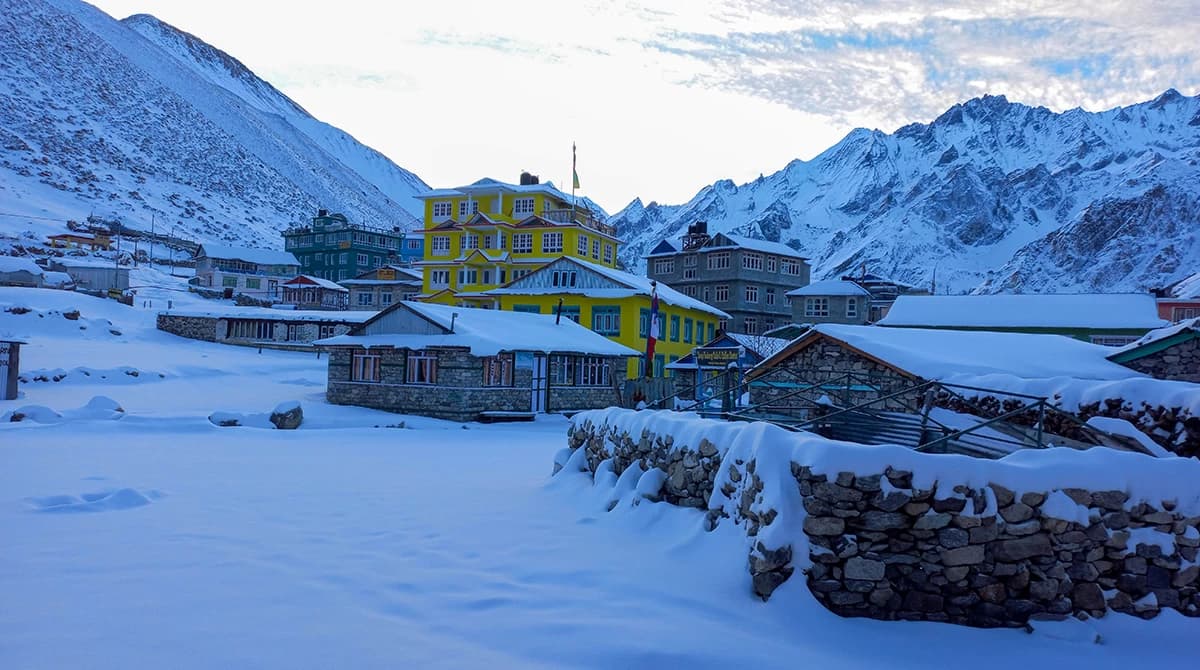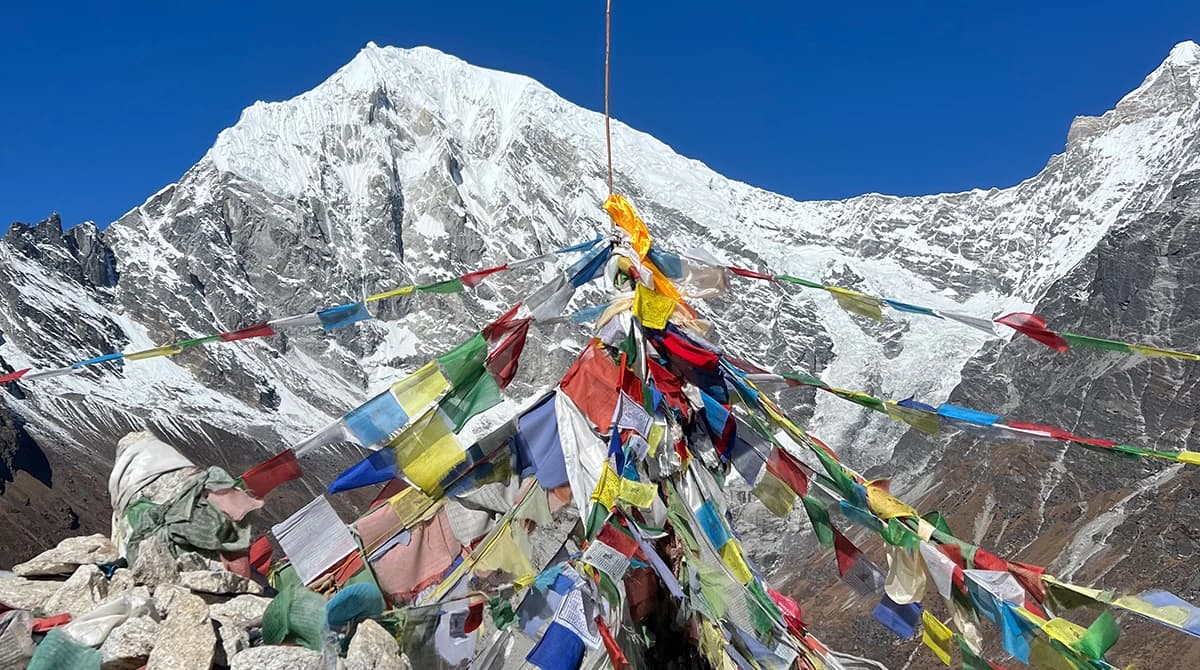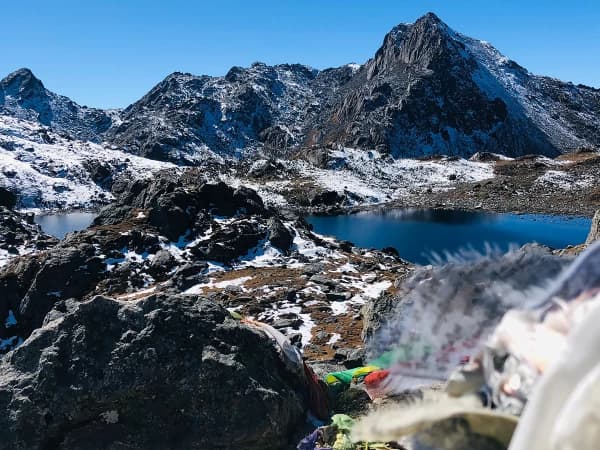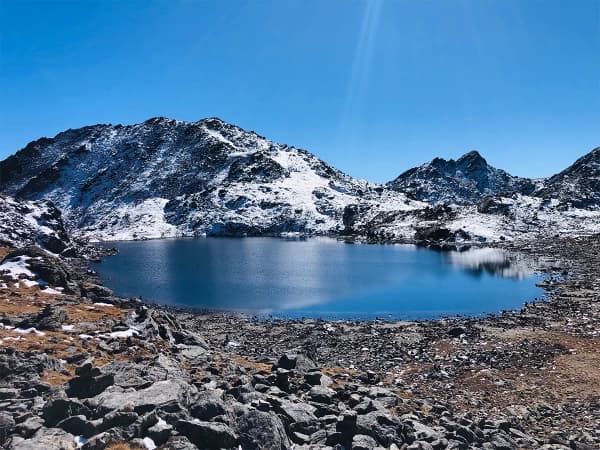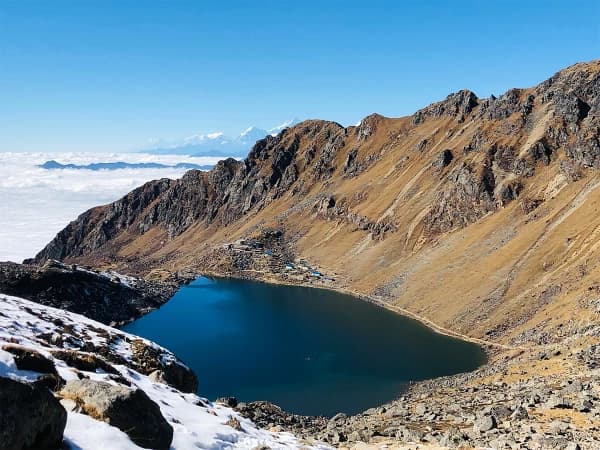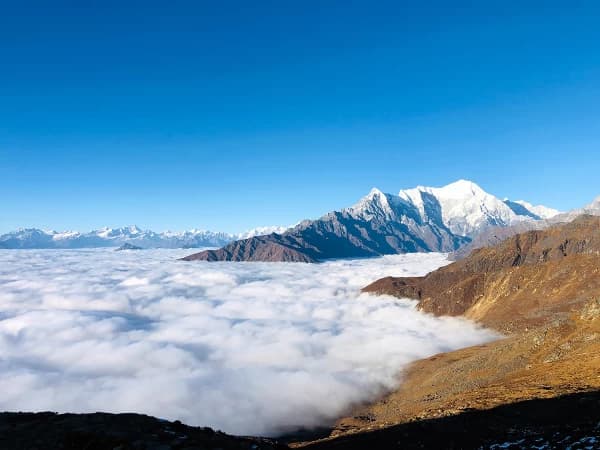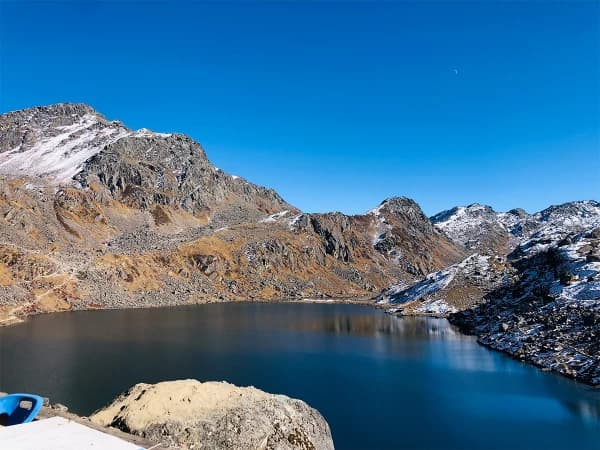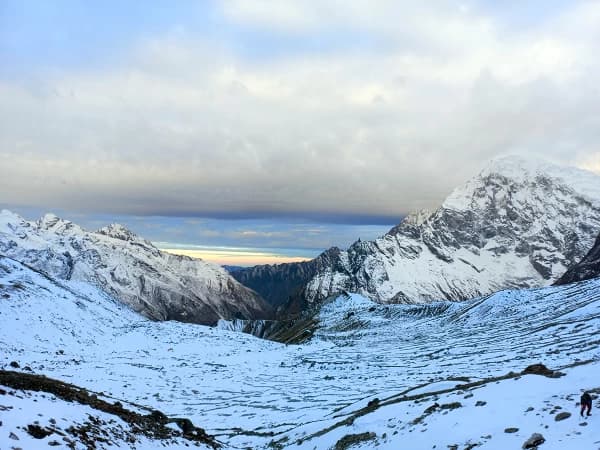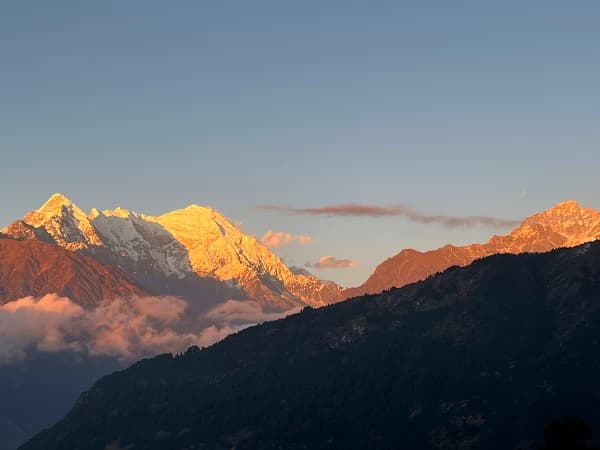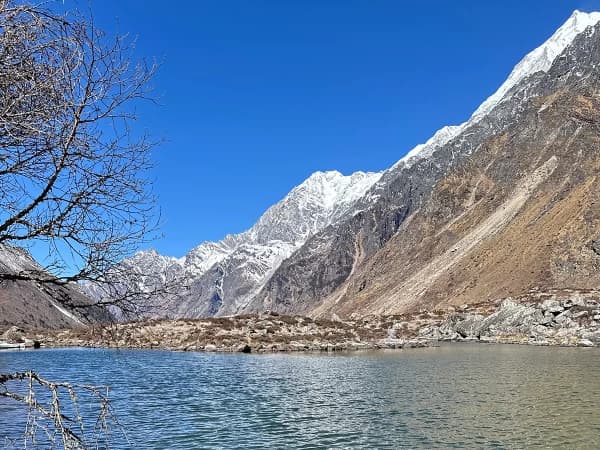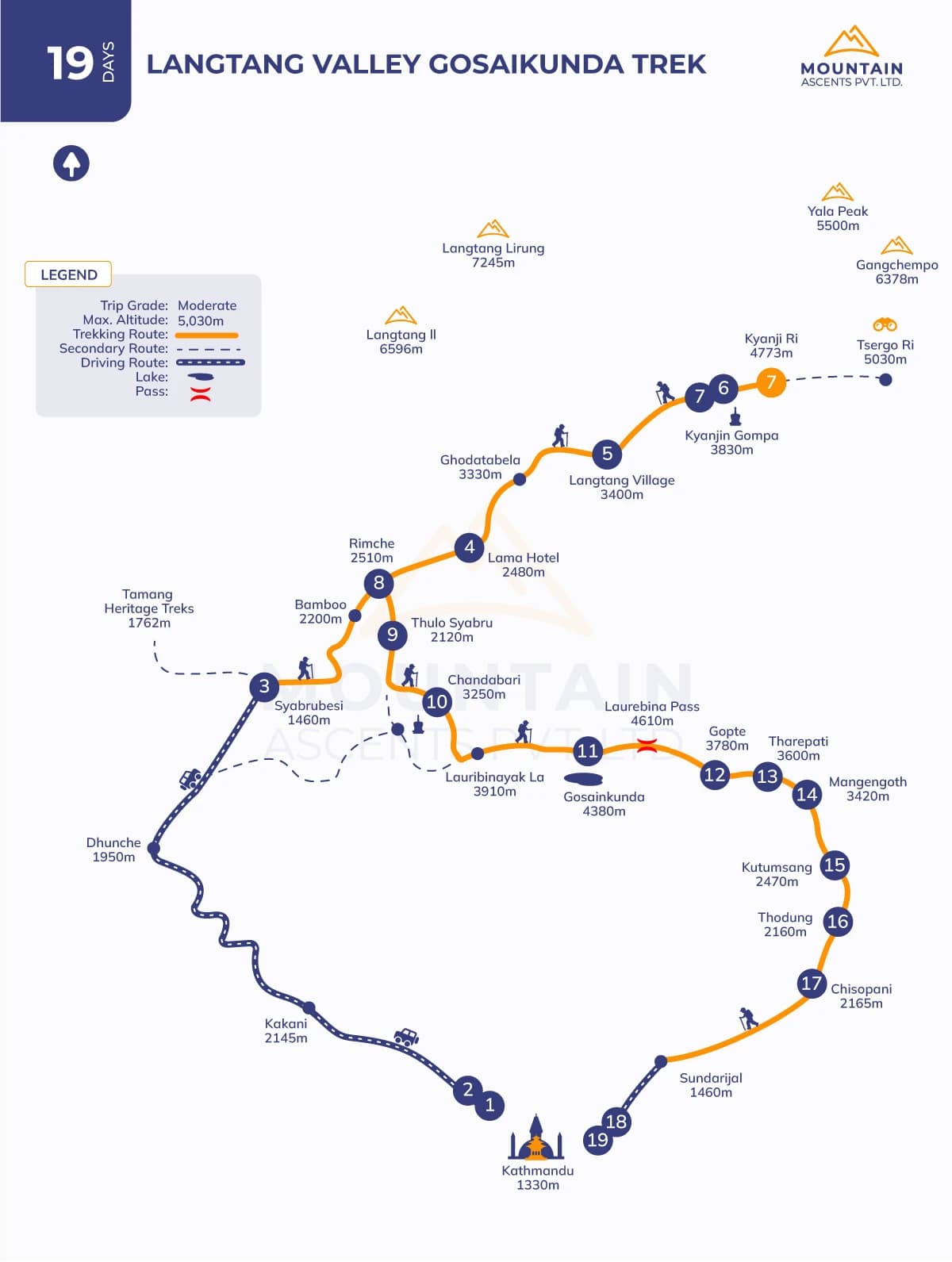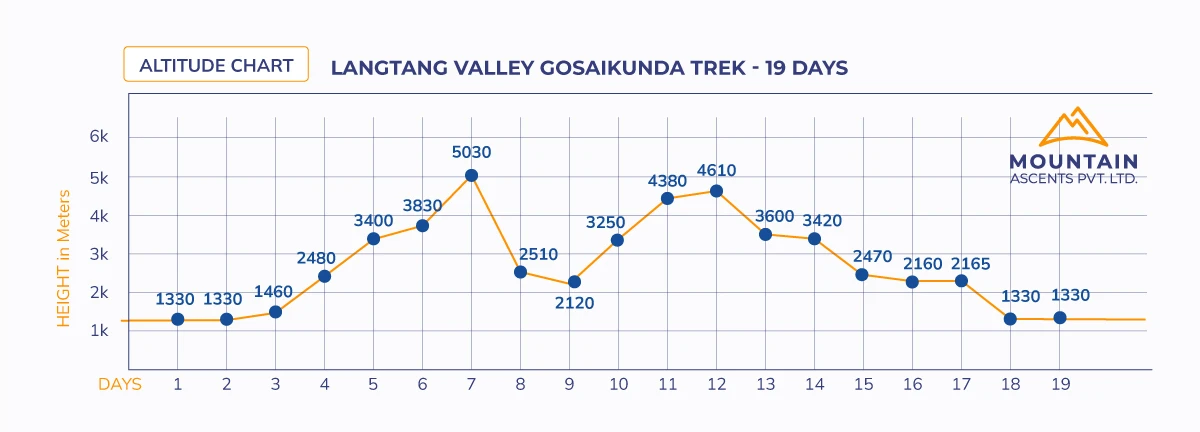The Langtang Valley Gosaikunda Trek is a unique trip through Nepal's Langtang area, where towering peaks, ancient cultures, and stunning scenery await you. This trek is through the first Himalayan National Park of the country, the Valley of Glaciers, which is a blend of natural beauty, cultural heritage, and adventure, gradually going uphill to the popular pilgrimage shrines of the high-altitude Gosaikunda Lakes. The lake, at 4,380 m above sea level, is revered by both Hindus and Buddhists. The itinerary for this breathtaking journey typically spans 15 to 20 days, where Mountain Ascents is offering the 19-day standard Langtang Valley Gosaikunda Lake Trek itinerary that officially commences with a drive from Kathmandu to Syabrubesi, the trek starting point, easily accessible via road.
The trek passes through beautiful Himalayan towns, lush forests, terraced farms, monasteries, and mani walls, all of which are inhabited and cherished by Tamang and Tibetan communities and are ideal even for novices stepping into the high-altitude Himalayan trails for the first time. The overall journey is easy to moderately strenuous, which at first is a drive along the Trishuli River and then the Langtang River with increasingly spectacular views of the surrounding Himalayan peaks such as Ganesh Himal, Dorje Lakpa, and holy Gosaikunda. Trekkers visit key destinations such as Langtang Village, Kyanjin Gompa, and Gosaikunda Lake, and cross one of the high mountain passes called Lauribina La Pass at 4,610 m above sea level amidst the spectacular, sky-towering mountain ranges with an incredible sight of the Helambu region of Nepal.
As you ascend and descend during the Langtang Valley and Gosaikunda Lake Trek, you will also get to enjoy the changing landscapes as you make your way through the lush forests, terraced farms, monasteries, and mani walls in the lower altitude and rugged beauty with the Tibetan-influenced culture in the upper Langtang Himalayan region in the center of the snow-capped peaks. To sum up, the Langtang Valley Gosaikunda Trekking is an excellent choice for trekkers seeking a perfect blend of natural beauty, cultural richness, and spiritual fulfillment, offering a comprehensive experience. The trek is slightly more strenuous than the Langtang Valley Trek, with an average of 5 to 7 hours of trekking per day, and reaches a maximum altitude of 4,610 m at Lauribin La Pass. From the sacred grounds of Kyanjin Gompa to the ascent of Gosaikunda Lake and Lauribina La Pass, the entire journey is filled with breathtaking views and incredible experiences.
Right from Kyanjin Gompa to Gosaikunda Lake and Lauribina La Pass, every single part of the journey is an experience, with mind-blowing marvels. Trek with us through the Langtang Valley Gosia Kunda Trek for a once-in-a-lifetime experience; discover the people and culture of Nepal, the beauty of the Himalayas, and the spirituality that has great value for this land due to its reward in view, community, and personal accomplishment. Hike this path with some of our reasonable package costs for 2025 and 2026, offering trekkers and nature seekers an unparalleled journey!
Trip Highlights
- Visit and unwind around the UNESCO cultural sites of the Kathmandu Valley, such as Pashupatinath, Swyambhunath, Boudhnath, and others.
- A joyous drive to reach the Langtang Trekking Region’s trek starting point, Syabrubesi, along the roaring river, traditional Nepalese villages, and lush hills.
- Traverse through the Langtang National Park of Nepal, offering a golden opportunity for immersive wildlife observation, including encounters with rare species of red panda, Himalayan tahr, musk deer, and others.
- Explore the hidden gems of Nepal in proximity to the Kathmandu Valley, the Langtang Valley, famous for its glaciers, dense forests of pine, oak, and rhododendron; green meadows; terraced farms; Tibetan culture; and spirituality-awakening landmark visits.
- Majestic views of sky-perching mountain range like Langtang Lirung, Dorje Lakpa, Gang Chenpo, Naya Kanga, Yansa Tenji, and others.
- Hike to the high-altitude Kyanjin Gompa and Gosaiukunda Lake, also serving as the major viewpoints of the Langtang Trekking Region, for a 360-degree full view of the surrounding Himalayas above and lush valleys below.
- A peek into the simple yet meaningful lifestyle of local Tamnag and Sherpa communities sharing close cultural ties with Tibetans and Tibetan Buddhism.
- Cross one of the adventurous high mountain passes, Gosaikunda Pass at 4,610 m, providing a sense of adventure, achievement, and serenity.
- A peaceful off-the-beaten-path nature walk through the dense forests of oak, pine, and rhododendron with the sound of nature, etc.
What makes the Langtang Valley Gosaikunda Trek special?
The trip to Langtang Valley and Gosaikunda Lake in the Langtang Trekking Region of Nepal is an exceptionally adventurous and remarkable journey that offers stunning mountain views, tribal Tamang villages, high passes, and a full exploration of glaciers, Gosaikunda Lake, the Langtang National Park, and the Shivapuri National Park. The 19-day Himalayan pilgrimage passes through varying vegetation, temperatures, and lifestyles, delivering a distinctive flavor of adventure.
Despite its closeness to the capital city of Nepal, Kathmandu, and its availability of well-established teahouses, lodges, and guesthouses, even after the destructive earthquake of 2015, it is less frequented and offers tranquil trekking trails for you to explore and contribute to re-establishing and lifting up the living standard of locals. The entire region embodies Himalayan resilience and unspoiled natural and cultural beauty for you to marvel at, added to much by the occasional encounter with wildlife like Himalayan black bears, blue sheep, and red pandas. In brief:
Awe-inspiring natural beauty
The Langtang Valley Gosaikunda Trekking route takes you through a dense vegetation area filled with rhododendron and bamboo forests with diverse wildlife, including langurs, red pandas, and various species of birds; scenic streams; and waterfalls cascading down the hillsides; rugged alpine terrain and meadows; and tranquil river valleys starting from Syabrubesi, also referred to as the gateway to the Langtang Himalayas of Nepal, approximately 122 km/76 miles north of Kathmandu.
These river valleys are called Langtang Valley, featuring picturesque villages amidst terraced fields and traditional stone, watched over by magnificent mountain ranges such as Langtang Lirung, Gangchempo, and Dorje Lakpa, and striking glaciers leading to its other name, “Valley of Glaciers. Around Kyanjin Gompa, trekkers can see a wide spread of grassy plains for yaks, glacial moraines, and debris, while sparse vegetation with steep trails cutting through rugged terrain and moraines near Gosaikunda Lake is actually a cluster of glacial lakes with crystal clear, turquoise water carrying spiritual significance for both Hindus and Buddhists in Gosiakunda Lake, where the ascending trek culminates.
Each stop—Lama Hotel, Langtang Village, Kyanjin Gompa, Rimche, Thulo Syabru, Chandabari, Goasaikunda, Ghopote, and others—promises you something distinctive of the Langtang Valley’s pristine nature to explore, discover, and appreciate.
First-hand cultural and spiritual immersion
The Langtang Trekking Region of Nepal is predominated by the Indigenous community of Tamang and Sherpa people who have kept their ancient traditions, culture, and traditions alive till this day. Showcasing a strong Tibetan influence, as the Langtang Valley Gosaikunda Trek continues through the heart of Nepal’s Himalayas, trekkers can experience their rich culture and spiritual lifestyle through local hospitality, traditional villages, mani walls, gompas, and monasteries, including Kyanjin Gompa and the Gosaikunda Lake itself which encourage trekkers to slow down, connect with their surroundings, and embrace mindfulness.
Nestled at an altitude of 3,870 m/12,697 ft above sea level, near the Langtang Village, Kyanjin Gompa is one of the most revered spiritual centers, an ancient monastery of the Langtang Region guarded by the majestic peaks like Langtang Lirung, Dorje Lakpa, and Yala Peak. This monastery serves as both the cultural and spiritual hub, offering insight into Buddhist traditions and views, perfectly creating a perfect place for meditation and reflection in serenity, miles away from hectic city life.
While the Chortens and Mani walls, often carved with holy mantras like “Om Mani Padme Hum,” and vibrant prayer flags are sacred along the trail, exuding spiritual energy and a sense of peace, a visit to Gosaikunda further enhances the experience. Set in a tranquil ambiance, Gosaikunda Lake is an alpine freshwater group of glacial lakes with calm, crystal-clear water originating directly from the melting of nearby mountains, creating an ethereal environment for self-reflection.
Located at 4,380m/14,370ft above sea level in the Langtang Valley, Gosaikunda is a significant pilgrimage site that is believed to have been created by Hindu Lord Shiva himself and is cherished by both Hindus and Buddhists alike. Every year, thousands of pilgrims visit the lake to bathe in its holy waters, which are said to cleanse sins and bring blessings, especially during the Janai Purnima Festival which usually coincides with the autumn seasons in Nepal.
High altitude challenge and adventure
During the Langtang Valley Gosaikunda Trekking journey, trekkers start walking from Syabrubesi at 1,460 m/4,790 ft above sea level and gradually ascend to the high altitude of 4,380 m/14,370 ft at Gosaikunda Lake and Laurebina La Pass at 4,610 m, also called Gosaikunda Pass, through forests, rivers, valleys with typical mountain villages, and alpine meadows. Above 3,500m, the air gets thinner, and reduced oxygen levels make it physically demanding to trek through steep ascents, particularly to Gosaikunda Lake and Lauribina La Pass.
Usually, these sections involve navigating rugged paths, moraines, and narrow ridges that may get snowy, icy, and cold during the months of winter in remoteness. Furthermore, the Himalayan weather is unpredictable and can change rapidly, and it may drop below freezing points at night. Therefore, proper acclimatization, gear and equipment, and support from local experts are essential for a successful Langtang Valley Gosaikunda expedition, which is also a chance to test yourself equally rewarding with jaw-dropping Himalayan vistas of the Langtang and Ganesh Himal ranges, spiritual fulfillment, and personal growth.
Experience authentic Village Life
The Gosaikunda Lake Trek passes through several traditional villages like Syabrubesi, Langtang Village, and Chandanbari, still retaining the traditional Himalayan life where locals are engaged in agriculture, animal husbandry, weaving, and spiritual practices. Tamangs are the predominant ethnic group and have a rich heritage influenced by Tibetan culture, evident in their language, cultural attires, and rituals, living in stone-built houses designated to withstand the harsh mountain climate.
Suppose your visit to the Langtang Region coincides with Lhosar (Tibetan New Year) or Janani Purnima. In that case, you may witness traditional dances, feasts, and rituals when the villages and pilgrims gather for rituals in monasteries like Kyanjin Gompa, Shin Gompa, and Gosaikunda Lake. As the main form of accommodation for trekkers during the Langtang Valley Trek combined with Gosaikunda is also tea houses run by local families, it allows for more seamless local interactions. In general, locals are friendly, hospitable, and often smiling. They love to share the stories of life in the mountains, challenges, and joys, leaving you in awe with their unparalleled resilience to the high altitude.
The villagers live in harmony with their environment, using natural resources sustainably, and it will be epic to gain Himalayan wisdom as you pass through remote settlements and interact with the locals. It is a heartwarming aspect as they share their daily meals, culture, and customs with you while they also provide you with accommodation and a place to rest. Therefore, trekking to the Langtang Valley Gosaikunda is not just about mountains but also a chance to forge a meaningful connection to nature and its people from the Himalayas as well as gain an insight into their resilience, strength, and hospitality in the face of challenging mountain conditions.
A unique blend of accessibility and tranquillity
Unlike the popular trekking trails in Nepal, like the Everest Base Camp, Annapurna Base Camp, and the Upper Mustang Valley Trek in the Everest Region, Annapurna Region, and Mustang Region, respectively, the Langtang Valley Gosaikunda Trekking’s start point is easy to reach and is more accessible than many other trekking regions. Located just a few hours’ drive from Kathmandu, it still offers a quieter and more intimate trekking experience far removed from the bustling city.
The trail to reach the Langtang Valley and Gosaikunda Lake winds through untouched forests, quaint yet lovely villages, and glacial moraines, all under the shadow of majestic peaks like Langtang Lirung, Dorje Lakpa, and others. With fewer crowds than other famous treks in the country, it is a perfect, easy, and quick escape for adventurers seeking solitude, isolation, and unmatchable natural beauty.
Langtang Valley Gosaikunda Trek 19 Days itinerary and cost for 2025 and 2026
The 19-day itinerary for the Langtang Valley Gosaikunda Trekking starts with your landing at Tribhuvan International Airport (TIA), Kathmandu, Nepal, where you will spend two days acclimatizing to the Himalayan air of the country before officially embarking on the trekking route, which initiates on the third day with an 8-9 hour drive to Syabrubesi. The fourth day is when you will officially begin the trek, which for the day is to reach Lama Hotel from Saybrubesi. Thereafter is a daily 5-7 hour walk proceeding through Langtang Village, Kyanjin Gompa, Rimche, Thulo Syabru, and Chandanbari to reach Gosaikunda Lake.
In between is an acclimatization day at Kyanjin Gompa allocated for a full exploration of one of the major cultural and spiritual heritages of the Langtang Trekking Region while trekkers also adapt themselves to the high altitude, low oxygen level, and remote Himalayan surroundings prone to acute mountain sickness (AMS), commonly called altitude sickness. By hiking high and sleeping at low, you can minimize the chances of getting altitude sickness, followed by adequate hydration, healthy eating, and a peaceful trek. Nonetheless, this Langtang Valley Gosaikunda Trekking Itinerary of 19 days from Gosaikunda Lake to return to Kathmandu involves crossing Lauribina La Pass, 4,610 m, acting as the major challenge demanding a good level of physical fitness and mental determination. The route thereafter is mostly an easygoing downhill trek through Ghopte, Therapati, Mangengoth, Kutumsang, Thodung, Chisapani, and Sundarijal, finally concluding at Kathmandu.
The journey takes place under the Langtang National Park of Nepal, home to a diverse array of flora and fauna and one of the indigenous Himalayan tribes of the country, the Tamangs, offering a perfect blend of culture and nature. Trekkers along the way are offered various perspectives of the Langtang Himalayas, including Langtang Lirung, Dorje Lakpa, Gang Chenpo, Naya Kanga, Yansa Tenji, and that of Manaslu and Annapurna, as well as from high-altitude landmarks like Gosaikunda and Lauribina La Pass in the distance. The monasteries, mani walls, prayer flags, and chortens dotted in between the traditional villages add much to the cultural and spiritual dimension, while the 19-day itinerary for Langtang Valley Gosaikunda promises you a smooth trekking experience without having to feel rushed and miss the major highlights that the Langtang Trekking Region has to offer.
It is meticulously crafted by mountain leaders and experts from Mountain Ascents so you get the best out of the best from this Himalayan voyage with zero comparison in your safety, health, and most enhanced experience. Further for 2025 and 2026, we are offering an early bird booking and group discounts on Langtang Valley Gosaikunda Trekking Cost. Book now and reserve your seat to experience amazing mid-hills and high-altitude lakes in the Langtang Region of Nepal.
.webp&w=3840&q=75&dpl=dpl_D3B2L6tNU7WkjoPZJKaFAADU1SuR)
